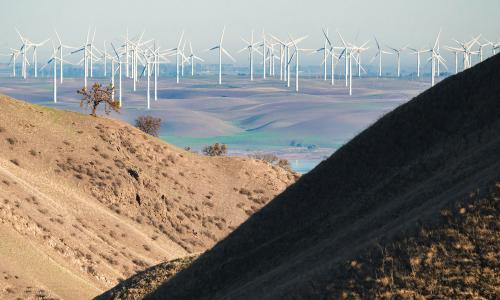Nestled into the waters of Casco Bay in Portland, Maine, is a stand of discarded pilings, worn and decaying wooden posts that once supported a long-gone commercial dock. As of today, and until November of this year, Portlanders and visitors to the city will see some unusual creatures among the pilings. Local artist Andy Rosen has built two deer out of aluminum, steel, and foam, outfitted them with long, slender stilts, and planted them right in the water—part of a nationwide set of art installations funded by Science Rising and the Union of Concerned Scientists (UCS).
“These seemingly derelict spaces where animals reside, or where nature is being pushed out and growing back in, are very interesting to me,” says Rosen of his decision to locate his installation TREAD by the pilings. “I’m thinking about these deer as non-seafaring animals that are now seafaring animals—it’s almost like a folk tale of my own.”
UCS has awarded six grants of $10,000 this year to individuals and artist collectives in six American cities, as part of its pilot Art for Science Rising initiative. Art for Science Rising funds public-facing art that highlights the importance of science to protecting our health and safety; each event associated with these installations is staged as part of Science Rising, a national movement to ensure science is front and center in decision-making processes that affect everyone in the US.
Rosen says he’s pleased to be part of this conversation on science, noting that the waters of the Gulf of Maine, where the deer are located, are warming faster than most of the global ocean.
“My work for the last 15 years reflects my relationship with the environment,” he explains. “I’ve been thinking about the metaphors that are often used for climate change—how we visualize what this huge, perhaps abstract thing is—and this is a way to figure that out on my own terms. We as artists who are interested in these things must help visualize what’s going on.”
When the tide comes in, Rosen says, the deer will be partially or nearly fully submerged. When it recedes, the stilts will be visible. “There’s something about the presence of the water that I can’t predict, that’s peaceful and threatening at the same time,” he says. “I’m trying to imagine an experience through some other being.”
If you look closely at TREAD, you might observe a personal element of the work that Rosen, who has two children, did not intend as its main message. His deer are young, not fully grown—intentionally, says the artist.
“In some ways, these deer are taking on the characteristics of my children,” he says. “This is a way in which I can envision what the future is like, on a very personal scale.” The other five Art for Science Rising installations are scheduled for unveiling later in September.
Artist’s statement for TREAD:
My works address how my conception of the environment is influenced largely by a fairytale-esque sense of how the world works. In the space between imagination and reality is an attempt to better understand the human role in the natural world. This particular tale tells of the effects of rising seas and habitat encroachment.
This is future folklore: about the dislocation of animals from their traditional habitat and their imagined adaptation in a new one. Outfitted with stilts, these young deer set out on a voyage amidst abandoned wooden pilings—themselves once in another habitat, perhaps together as trees—and the hulking modernity of gleaming white cruise ships docked just beyond. Amidst the coming and going of travelers for pleasure is an imagined scene of animals traveling for other purposes.
You may look at this work and see animals out of place. Do you also see us?



